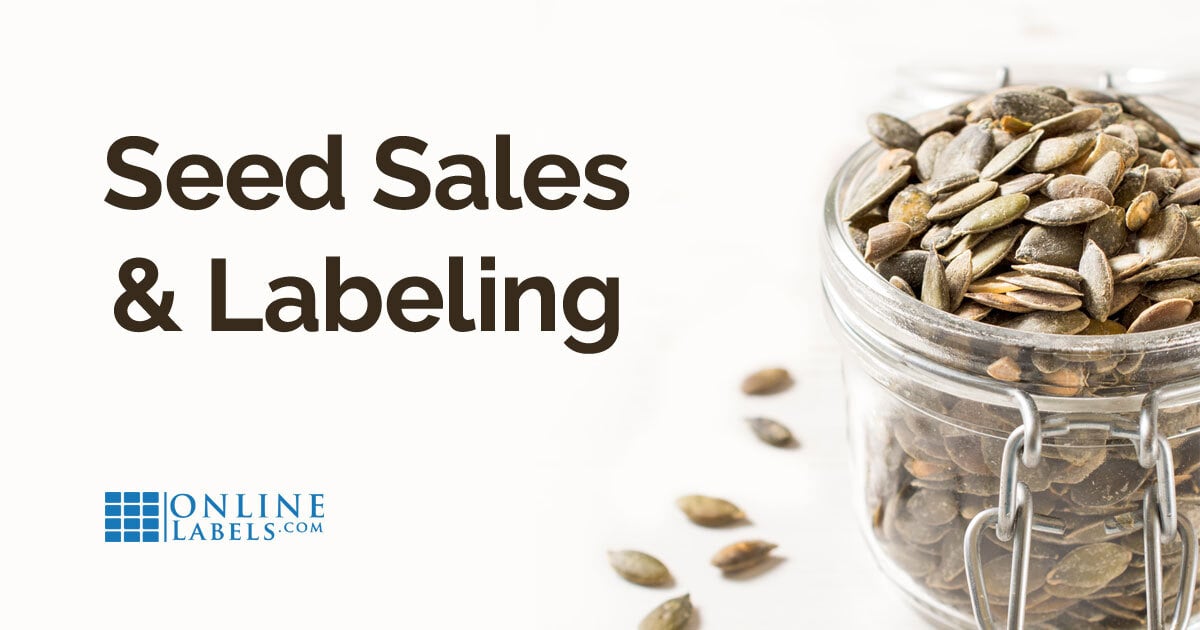The Ultimate Guide On Labeling Regulations For Online Plant Seed Sellers in the U.S.

Gardening as a hobby is seeing a massive uptick in popularity during COVID-19 times. People are stuck at home and turning to gardening – in large part because it's peaceful, relaxing, and nurturing for the soul.
As such, selling seeds is a great side hustle to get into. More and more shops are popping up online, especially on sites like Etsy, where it's easy to start an online store. That opens up huge opportunities for competitors to serve the need for seed.
In this article, we're going to explain what you need to know about labeling seeds for sale to legitimately and safely sell seeds and grow a profit!
Labeling seeds in your garden? Learn more about garden labeling.
Seed Regulations
The U.S. government regulates the selling and transportation of seeds. Among other things, these regulations lay out how you need to label your seeds to abide by the law and keep the wider community safe.
Historical Background
The Federal Seed Act (FSA) outlines seed selling and labeling regulations. It was originally created in 1940 and revised in 1998 by the United States Department of Agriculture's (USDA) and is enforced by the Agricultural Marketing Service (AMS). The AMS also provides seed testing services to help seed sellers communicate accurate information.
How Seed Labeling Regulations Help Protect U.S. Citizens & Agriculture
Seed labels help consumers know the species, variety, and amount of seed they're planting. And the FSA overall helps promote uniformity among state laws and fair competition within the seed trade.
This matters because the agricultural industry comes with a whole host of concerns. Are people growing what they've been told the seed will grow? Have seeds been genetically modified or not? Is the competition being truthful, or are they boasting a set of features that aren't true?
That's why the AMS and other organizations provide seed testing services to enforce truthfulness in the information and advertisements that come from seed sellers. The goal is to help consumers stay safe, plant what they intend to plant, and have all the information they need to make informed buying and planting decisions.
Regulatory Penalties
The AMS states that any violation of the FSA will be judged as a misdemeanor and punishable by a fine of up to $100 for the first offense, and up to $200 for each subsequent offense.
Keep reading and we'll give you the need-to-knows to avoid paying up.
Anatomy Of A Seed Label
The FSA details a host of seed label requirements, which become more specific depending on the type of plant your seed will grow. We've simplified those requirements for you here, so you don't have to comb through the dense and jargon-heavy text.
Download our grass seed bag label template to get started.
1. Product Name
The brand name, species name, and/or common name. By listing the brand name and species/common name together, a consumer can distinguish one product from another.
2. Contact Information
Name, address, and contact information for the company providing the seed and responsible for analysis (seller and/or grower).
3. Origin
State where the seed was grown.
4. Lot Number
A unique series of letters or numbers assigned to each lot of seed by the grower for tracking purposes so that the seed can be traced to its origin. This number appears on the tag/label on the seed lab documents, purchase orders, etc.
5. Test Date
The month and date that the lot was tested for germination in a lab. Date should be within 12 months of the planned date for using the seed.
6. Net Weight
How much material is in the container.
7. Pure Seed Percentage
The percentage by weight of material in the bag that's actually the desired seed(s).
8. Other Crops Seed Percentage
The percentage by weight of material in the bag that contains seeds other than the varieties labeled, but not considered weed seeds. If "other crop seed" is over 5% of total weight, it must be listed by name on the seed label.
9. Weed Seed Percentage
The percentage by weight of material in the bag that is weed seeds, unless they're considered restricted noxious weed seeds by law in the state where the seed will be sold.
If they are restricted noxious weed seeds, they must be listed individually by name on the label and are limited to the amount allowed by state law (usually around 0.25%, but check your state's seed laws to make sure). Note that prohibited noxious weed seeds are not allowed at all, i.e. should be at 0%.
10. Inert Matter Percentage
The percentage by weight of material in the bag that doesn't grow i.e. broken seed that is half or less what was originally there, hard & dormant seed, seed coats, insects, etc.
11. Germination
The percentage by weight of material in the bag that is expected to grow (based on a lab test).
12. Treatment
Coatings such as a fertilizer, chemical, microbial, bacteria, or clay/polymer coating generally used to enhance germination, protect the seed from insects or disease, or assist in growth.
13. State-Required Items
States may have additional labeling requirements as these are the federal labeling requirements. Specific seed laws of the state where the seed is being sold should be consulted.
How To Lab-Test Your Seed
Seed label details are provided by a test from a seed lab. Labs and lab testers are certified by two organizations: the Association of Official Seed Analysts (AOSA) and the Society of Commercial Seed Technologists (SCST). The AOSA is composed of state, federal, university and some crop improvement labs and the SCST is composed of analysts from seed companies, private labs, crop improvement labs, and some AOSA labs.
You can find labs simply by Googling "seed testing laboratories" near you. Expect seed testing to cost you somewhere in the range of $35-$180, depending on the type of seed you're testing, the size of your sample, and the lab's fees.
Shop Seed LabelsWhite-Labeling From A Seed Company
If you don't want to grow, test, and sell your own seeds, you can instead "dig up" a wholesale seed supplier to partner with. Simply search for wholesale seed suppliers/distributors in your area.
Do your research to find a reliable partner, though. Don't stop at the first page of search results and don't be afraid to ask local gardeners and farmers, either. Once you do find a partner, you'd take over branding and marketing and will still have to comply with the seed labeling regulations outlined in this article.
Discover more about white labeling products.
Both federal and state seed laws are intended to benefit consumers and producers. Consumers win by purchasing seeds they know they can trust to be what they expect, and producers win by knowing their competitors are being truthful and the market is fair.
Because these benefits are so important, violation of seed laws results in troublesome financial and legal consequences. Don't risk it! Follow our simplified guidelines on labeling seeds for sale, and you'll be able to easily start creating your seed labels with OnlineLabels.com today.
Will your business be ready when the world opens back up? Find out how to start selling at markets, or hone your online presence with tips to keep business moving while at home.


